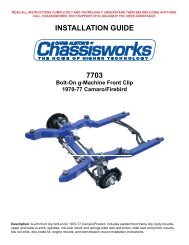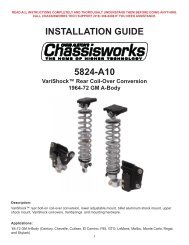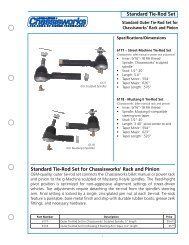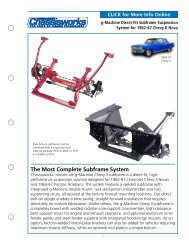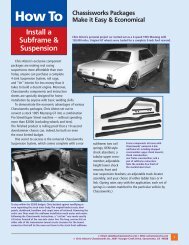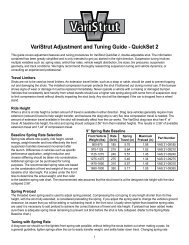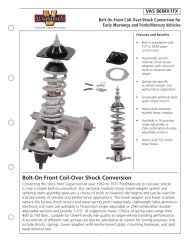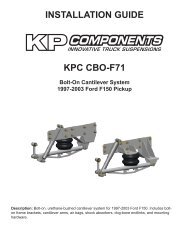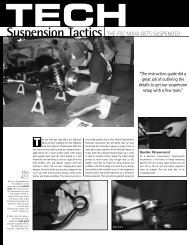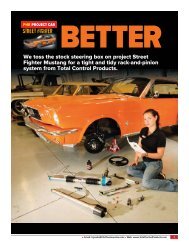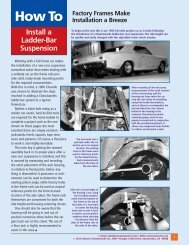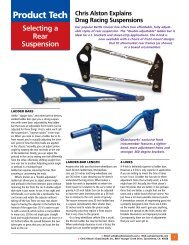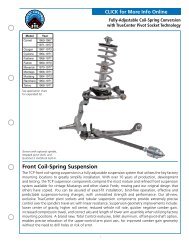Installation Instructions - Chris Alston's Chassisworks
Installation Instructions - Chris Alston's Chassisworks
Installation Instructions - Chris Alston's Chassisworks
Create successful ePaper yourself
Turn your PDF publications into a flip-book with our unique Google optimized e-Paper software.
Ride HeightWhen a shock is at ride height a certain amount of travel is available in either direction. Depending uponperformance application, shock travel will be reserved in different percentages for compression or extension.Street Baseline: 60-percent Bump, 40-percent ReboundStreet vehicles require more available compression (bump) travel for improved ride quality and unexpected roadhazards. At baseline ride height, the shock and spring should collapse 40-percent from their installed heights.This results in 40-percent of travel available for extension and 60-percent for compression travel.Handling Baseline: 50-percent Bump, 50-percent ReboundHandling performance applications are usually limited to smooth prepared road-course- or autocross-tracks,therefore less compression travel is required. Suspension geometry or track conditions may require the travelpercentages to be shifted to prevent topping- or bottoming-out the shock.Drag Race Baseline: 40-percent Bump, 60-percent ReboundDrag race vehicles generally require more extension (rebound) travel to help weight transfer, and because thedrag strip is very flat, less compression travel is needed. The amount of extension travel available in the shockwill drastically affect how the car works. At baseline ride height, the shock and spring should collapse 60-percent from their installed heights. This results in 60-percent of travel available for extension and 40-percent ofcompression travel.Baseline Spring Rate SelectionSpring rate affects ride quality, ride height, stored energy, weight transfer and how effectively the front suspensionhandles downward movement after drag race launches. Differences in vehicles such as specific performanceapplication, weight reduction and chassis stiffening should be taken into consideration. Additional springs can bepurchased for tuning purposes. The recommended spring rates are based on the combination of weight of the carand baseline ride height.Spring PreloadThe threaded lower spring seat is used to adjust spring preload. Compressing the coil spring to any length shorterthan it’s free height, with the shock fully extended, is considered preloading the spring. If you adjust the springseat to change the vehicle’s ground clearance, be aware that you will be adding or subtracting travel in the shock.Usually when lighter-than-baseline spring rates are used it is necessary to add preload to achieve the correctbalance of travel and ride height. If preload has been added make sure there is adequate spring travel remainingto prevent coil bind before the shock is fully collapsed.Tuning Front Suspension with Spring Rate (Drag Race)A drag race car should run the lightest front spring rate possible, without letting the shocks bottom out whenmaking a pass. As a general guideline, lighter springs allow the car to easily transfer weight, and settle fasterdown track. Changing spring rate affects ride height and the rate at which weight is transferred to the rear tires. Asofter rate makes the front easier to raise during acceleration. A stiffer rate makes the front harder to raise duringacceleration. If you are having trouble getting the front end to rise, you can soften shock valving or change to asofter spring. When using lighter rate springs preload must be added by screwing the lower spring seat upward,compressing the spring to achieve proper ride height. In general terms, the worse a car hooks the more shockextension travel it will need. If you need more extension travel, preload can be removed to lower ride height.Using this method will cause the car to have less ground clearance and reduce the amount of compression travel.If you are going to operate the shock at a ride height shorter than recommended, the upper chassis mountsmust be relocated to correct any major vehicle ride height issues. It may take some work with spring rates andupper mount relocation to get the correct combination of vehicle ride height and front suspension travel for yourapplication.Adjustment FeaturesThe QuickSet 1 valve system features a single adjustment knob that controls overall damping stiffness ofthe shock. Knobs are clearly etched indicating the correct direction of rotation to decrease (-), or increase (+)damping stiffness. There are a total of 16 specific adjustment positions.



